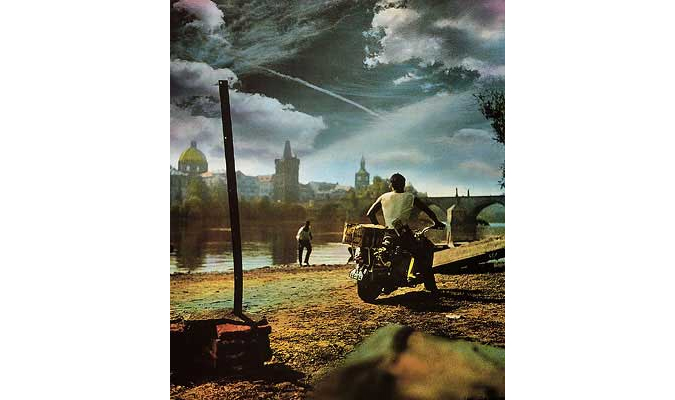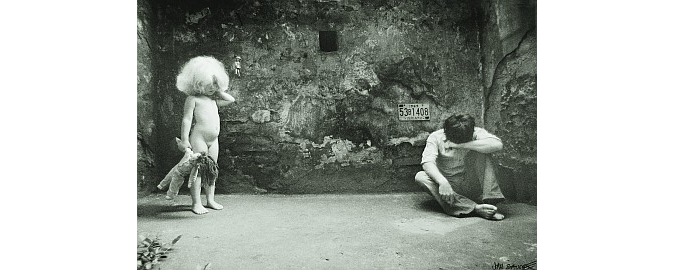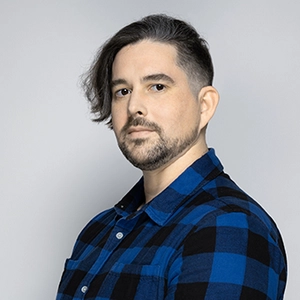If you’re a pop aficionado of a certain age, you’ll probably remember the British band Beautiful South and its debut album, Welcome to The Beautiful South.
What’s much less well known is the piece of Czech-related trivia connected with the album, released, rather appropriately, in the momentous year of 1989. The photographs of a man and woman featured on the cover are the work of Czech photographer and artist Jan Saudek. He’s one of the most well-known artists in the Czech Republic, and globally is regarded as the most celebrated Czech photographer.
He’s also controversial and, it’s probably safe to say, the kind of artist who falls into the “you either love him or loathe him” category. In the eyes of his admirers, he’s honest and original; his detractors would argue he is a tortured exhibitionist with nothing new to say. But everyone can agree on his ubiquity. Even if you’ve lived here for a just short time, you’re sure to have seen his photographs of nude figures against tinted backdrops.

Hey, Joe!, 1959
Saudek’s life in the media spotlight post-1989 is much chronicled, and his recent exploits include a legal battle with his son and his son’s partner (who also just happens to be Saudek’s ex-partner). The spat was over the rights to some of his works, which was claimed he relinquished in 2005, but in June 2012 the court ruled in Saudek senior’s favor.
Despite his win, helplessness and a lack of control are themes running through Jan Saudek’s life, and his early years bear this out. His back story is noteworthy too, tied to the fate of Czechoslovakia. He was born in Prague in 1935, the younger of twin siblings, “so I am predestined to spend all my life as number 2,” he said.

Temptation, 1965
Saudek was still a young child when the Nazis invaded Czechoslovakia in 1939. They deported his father Gustav, who was Jewish, to the Theresienstadt Terezín concentration camp, 60 kilometers miles north of Prague, just a few months before the Second World War ended. Many of the photographer’s family members perished in the notorious fortress, from where inmates were sent to Auschwitz-Birkenau and other concentration camps, although Gustav survived. Meanwhile, Jan and Karel were detained in Auschwitz-Birkenau concentration camp, where Josef Mengele carried out his monstrous experiments, especially on twins. Saudek and his twin brother escaped this fate and ultimately survived.

Pieta No. 1, 1971
When the Communists seized power in Czechoslovakia three years after the Second World War, Saudek was just entering his teens, and a couple of years later he acquired his first camera, a Kodak Baby Brownie in 1950. He worked for a photographer, and in 1952 became a print shop worker, where he stayed until 1983. As the 1950s progressed, Jan Saudek developed his photography skills, and he also started to develop his skills in painting and drawing. Military service followed in 1955, and his next step was to pursue his photography career, after seeing the exhibit catalogue of Steichen’s Family of Man, at some point during the 1960s. Saudek also reveled in the era of rock and roll, which had arrived, and the music of bands such as The Rolling Stones and Roy Orbison inspired him. During the more liberal political climate of the Prague Spring, Saudek traveled to the United States and was encouraged by Hugh Edwards, head of photography at the Chicago Institute of Art. He also held his first exhibition, in the USA, at the University of Indiana.

Tell Me, Mirror, 1978
Saudek returned to Prague, and in the years that followed were characterized by moderate success but also bouts of deep despair. In the 1970s his work was not well known, and he was plagued from depression. Drugs were his attempt to deal with his problems. His son David also suffered from a long illness throughout this decade. In 1983, he gained a wider audience through the publication of The World of Jan Saudek, the first book in English on his work. That same year he also became recognized as freelance photographer, and Saudek could now apply for permission to be an artist. Despite these moves forward, Saudek continued to suffer, and 1987, negatives of his photographs were seized by his family in a blackmail attempt, although they were returned five months later. He described the period “as probably the worst time of my life”.
Jan Saudek is most well-known for scenes with nude or semi-nude figures – ordinary people – against a backdrop of bare plaster walls or painted backdrops, which appear repeatedly in his works. Other backdrops include cloudy skies or Charles Bridge. In many works he adds tints to colours, giving the images a dreamy feel. Many earlier works, from the 1960s, are in black and white and have a different, more naturalistic feel. Recurring themes feature strongly in Saudek’s work, for example childhood, and the relationship between men and women. He also uses the same models over again in his photography.

New View from My Window, 1985
The photographer and artist has won numerous and prizes over the years, and his popularity was inevitably boosted after 1989. In 1990, he was even awarded the Chevalier des Arts et des Lettres (Order of Arts and Letters) one of the highest honors in France, in recognition of his services to culture. But Saudek received his first reward in his native country only 16 years later, receiving the Artis Bohemiae Amicis, from the Czech Ministry of Culture.

Brothers, 1986
Family life
The twists and turns of Saudek’s family life are almost as famous as his photography, and could merit a separate article. He married Marie in 1959 and they had two children, Samuel and David. Saudek and Marie divorced in 1970, and in the years that followed he had a series of relationships, some of which resulted in children.
His former long-term girlfriend, Sára, is now the partner of Samuel Saudek, one of Jan Saudek’s sons, and Saudková and Saudek junior have four children. Saudková met Saudek senior in 1991, after being attracted to his work and writing him a letter. Saudková is also a photographer; her work typically features nudes, and the use of tinted color, and there obvious comparisons with Saudek’s style. Saudková has pointed out that her former partner has influenced her work.

The Last Tango in Prague, 2000
Interestingly, despite the breakdown in the relationship between Jan Saudek and Sára Saudková, if you go to Saudek’s website (see below), you’ll still find a large section devoted to Sára‘s work. You can easily see the similarities in style between the former couple.
Where you can buy his work
Currently, there is a commercial exhibition in Galerie Nové Butovice where you can see and buy many of Saudek’s photographs. Copies of Saudek’s (and Sára Saudková’s) photographs can also be bought directly via Saudek’s official website, www.saudek.com
Related articles













 Reading time: 5 minutes
Reading time: 5 minutes 
























